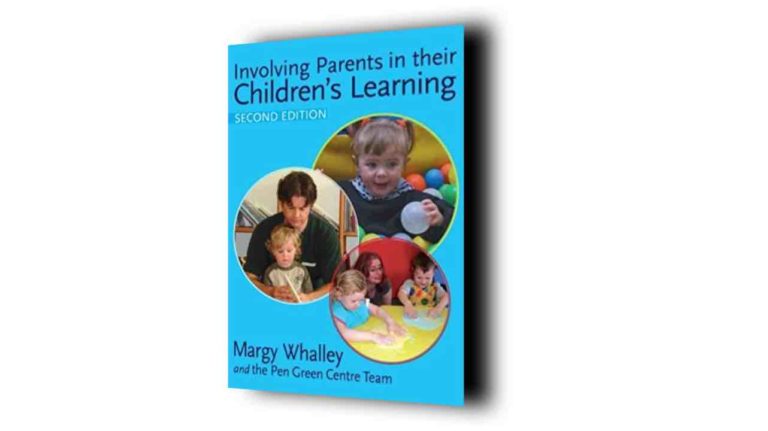Recommended Resources
Involving Parents in their Children’s Learning 2nd Ed by Margy Whalley
Posted on February 1, 2009.
“This book is just one of the outcomes of a five-year research and development project at the Pen Green Centre for under fives and their families”. So starts this book and you know it is going to be full of interesting findings. Of course, it helps that Margy Whalley, who has been involved in education for 34 years, around the world, has been leading and directing the research programme.
The 12 chapters are each written by different authors, all of whom were involved in some way with the project at Pen Green, Corby called Parents’ Involvement in Their Children’s Learning (PICL). The authors range from teachers, social workers to researchers and education consultants.
The book starts with a background chapter about Pen Green and its endeavours. In the next chapter, ‘developing evidence based practice’, Margy Whalley discusses the way the project has developed. It contains some essential insights for anyone setting up research projects where children are being observed and details the additional benefits for the adults involved.
In ‘getting to know the families’ Colette Tait discusses how knowing the family situation is vital when planning meetings. From the shift patterns that parents work to the wording on the advertising flyers (mums prefer to “have a chat and a coffee” whilst dads prefer “coming to this meeting will make a difference to your child”). It highlighted for me that you have to consider all the various home situations if you are going to engage parents successfully. Cath Arnold continues with this theme in further practical ways such setting up the room, which topics to cover, which theorists to draw on.
Chapter 5, ‘parents and staff as co-educators – ‘parents’ means fathers too’, by Margy Whalley and Trevor Chandler is inspirational. How many times have we heard “dads just don’t want to know”? This chapter shows not only how to involve fathers effectively but also the fantastic benefits to the child, father and other significant adults. This is essential reading for every setting and is the most comprehensive writing I’ve come across on the subject.
Cath Arnold writes an emotionally moving chapter about parents who find the services ‘Hard to Reach’, which, in the cases highlighted, means that the parents had had very negative school experiences themselves. This was stopping them getting involved with the centre’s activities – Kate says “I’m not the type – Pen Greeny”. So the two mums were interviewed and allowed to explain their own experiences, feelings and the consequences. In this way the barriers, including personal feelings and attitudes to other people, were identified so they could be overcome. Annette Cummings, in the next chapter, goes on to discuss the impact on parents’ lives, with some great case studies in the parents’ own words.
In chapter 8 we meet the Pen Green Loop, which is a feedback loop with the child in the centre, surrounded by parents and professionals and the Possible Lines of Development (PLOD) wheel. I particularly liked the PLOD wheel, as it has at the centre a small group of children, all of whom enjoy similar schemas. I often hear “how can we possibly plan for 40 different children? We can’t have 40 carpet areas!”. This is how it is done. First identify the children’s schema and then transpose this onto the centre of the wheel. There are 6 ‘spokes’, representing the 6 areas of learning, where activities and ideas can be mapped out for the group of children with similar or overlapping schema. Genius!
Colette Tait discusses the Growing Together groups which are for the birth to 3 age groups, discussing how it evolved out of the PICL group. The value of video taping the parent child interactions and then reviewing these is emphasised.
In ‘deepening the dialogue with parents’ Eddie McKinnon shares with us some in depth conversations with parents about their children, and how, as a result of being involved with the project this has made parents more reflective in their own practice.
But what happens to the family groups when the children start school? Cath Arnold presents 3 case studies, following the parents through Pen Green and then into Primary school, with very positive results.
Finally we have Kate Hayward, a primary school teacher, who was concerned with her own interactions with parents at school. She followed the good practice demonstrated at Pen Green and reports how she reinvents the traditional ‘home-school book’ model when communicating with parents. This chapter ends with a glowing recommendation from the headteacher.
This book is an excellent reference book, steeped in thorough research and viewed through many lenses. The concepts are explained clearly and examples are enlightening. Each chapter is written so it can be read independently, which means an amount of repetition when reading the whole book. However, I found the reinforcement of schemas, involvement levels etc reasonably useful. I was asked a while ago “why do we listen to these ‘theorists’ about good practice?”, to which I answered that they had done research and then tested their theories, proving that it was good practice. I think this book demonstrates this point and beyond.
It is available from Amazon

